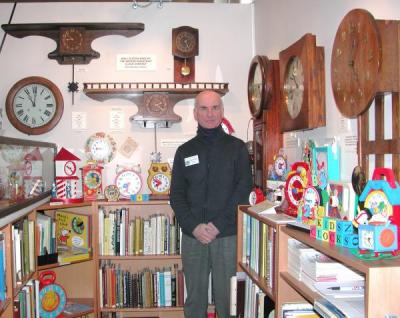 | | Allan Symons, founder, standing in the museum's reference library. |
IN JULY 2025 CELEBRATING MORE THAN 17,000 VISITORS
and MORE THAN ONE HUNDRED THOUSAND online views
NOW a Virtual Tour via the Home Page link
THE START: The Canadian Clock Museum opened to the public in Deep River, Ontario in late May of 2000 as Canada's only clock museum. This non-profit, private museum operates as a federal corporation (since December 1999) that is dedicated to collecting, preserving, researching, and exhibiting the products of Canada's many clock manufacturers and sellers from the early 1800s to current times. The research has now led to the publication of twelve peer-reviewed articles in the NAWCC Bulletin (in Pennsylvania) about lesser known Canadian companies. More articles are in the 'pipeline'.
TOURS: A guided tour, included in the admission fees, is offered to our visitors to provide more historical and technical details than can be put in the wall text panels. In addition, visitors can see dozens of period artifacts, and hear music played on working 1910s-1960s record players made by Edison (music cylinders), Columbia (78s flat records, windup table and portable models), Victor (78s floor model), and Electrohome (Kitchener, ca 1970, Canadian-made for vinyl LPs). Sights and sounds!
COLLECTIONS: A major collection focus is on clocks made by The Arthur Pequegnat Clock Company (Berlin/Kitchener, Ontario, ca. 1904-1941), the Canada Clock Company (Whitby, Ontario ca. 1872-1876), the Hamilton Clock Company (Hamilton, Ontario ca. 1876-1880), the Canada Clock Company (Hamilton, Ontario ca. 1880-1884), Westclox Canada (Peterborough, Ontario, ca. 1920-mid 1980s), and Snider (Harry Snider's two companies in Toronto, 1950-1957 and 1957-1976).
There are some British connections, including a working ca. 1921 Synchronome master wall clock with connected slave dial and a Blick Time Recorders early 1930s factory clock on which visitors can print their "in" and "out" hours on a souvenir card. Many clocks have an American connection, from mid 1800s shelf clocks with Leeds County, Canada West peddlers labels to mid 20th century mantel and wall clocks made in Ontario factories by U.S. companies.
FOUNDER: The initial collection of more than six hundred clocks, watches, and related horological documents was provided by Allan Symons, a long-time resident of Deep River, retired research scientist, and the Museum's founder, first Manager, and Curator.
REGULAR ADDITIONS: By mid 2025 the Museum's collections have grown to more than four thousand horological items (not including the library), through both purchases and significant donations from many generous people. Ebay has been a major source of mostly mid/late 20th century modern clocks and related items, with more than five hundred winning bids since 2001. By 2010 Kijiji had become a very useful secondary online source, with the prices in CANADIAN $. Followed by Etsy in mid 2020 and now Facebook Marketplace in early 2021. Plus many of the antiques malls in Ontario are visited regularly, and online auctions have become excellent sources.
OLD TOOLS: A significant acquisition received by donation in 2001 includes more than two hundred old watchmakers' and clockmakers' tools, some of which are accessible in a new display set up in June 2012 by our summer student Nick. A century-old oak watchmaker's roll-top bench with foot-operated lathe was recently added to the exhibits. The massive steel flywheel is dated 1898! Donated items from old watch/clock/jewellery shops are received regularly with thanks from descendants of the original operators.
For example, in March 2015 we accepted from a surviving Ottawa relative and a longtime friend of Max Silverman his old oak work bench complete with his watch repair tools and spare parts. Mr. Silverman operated his own business, Dominion Jewellers, in downtown Ottawa for several decades in the mid/late 20th century.
LIBRARY: The Museum's own reference library has grown to more than seven hundred books that cover a broad range of horological topics, including all of the major Canadian and American clock companies. There are children's books for learning to "tell time", and modern electronic time-teaching clocks. New book titles are added regularly.
In addition, we have a complete hard-copy set of the NAWCC Bulletins (National Association of Watch and Clock Collectors, Pennsylvania) and many AHS journals (Antiquarian Horological Society, England). There are also almost three hundred issues of the British publication Clocks Magazine.
These major research resources are used to answer the many questions about clocks that are received regularly through our web site from people around the world.
RESEARCH & PUBLICATIONS: Extensive research on lesser known 20th century Canadian clock companies has led to twelve published articles so far (late 2025) in the Pennsylvania-based NAWCC Bulletin. The first four were Harry Snider's two companies in Toronto (published in 2010) (in business 1950 to 1976); Walter Stonkus' company WALTER CLOCKS in Toronto (in 2015) (mid 1930s to late 1950s); Girotti Sculptured Art in St. Catharines, Ontario (in late 2015) (early 1960s to late 1970s) and Paul Pequegnat's company in Manotick, Ontario (in late 2017) (1984-1997).
FUNDING: The sources for museum operation and acquisitions funds are admission fees, cash donations, various granting agencies (especially the Ontario Trillium Foundation and Young Canada Works in earlier years), and the monthly pension cheques of the founder (he must be crazy!). But he considers this unique museum to be his personal millennium retirement project (started back in late 1999) and his special contribution back to the province of Ontario and to Canada. Still ticking in August 2025 after twenty-five great years!
All revenues, including admission fees and financial donations, are used to pay basic operating expenses and to acquire clocks and other artifacts that broaden the Museum's collections. Sometimes a summer student is hired, but there are no full-time paid staff - the museum.is strictly volunteer run.
REGISTERED NON-PROFIT CHARITY: The Museum is registered with the Canada Revenue Agency as a charitable organization. Tax receipts are issued regularly for donations, both financial and "in kind" items (for example a clock, watch, books, old tools, and clock company catalogues). Donations can be made through the CanadaHelps web site at www.canadahelps.org. |